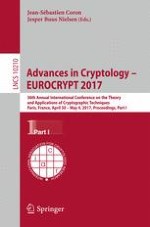2017 | OriginalPaper | Buchkapitel
Robust Transforming Combiners from Indistinguishability Obfuscation to Functional Encryption
verfasst von : Prabhanjan Ananth, Aayush Jain, Amit Sahai
Erschienen in: Advances in Cryptology – EUROCRYPT 2017
Aktivieren Sie unsere intelligente Suche, um passende Fachinhalte oder Patente zu finden.
Wählen Sie Textabschnitte aus um mit Künstlicher Intelligenz passenden Patente zu finden. powered by
Markieren Sie Textabschnitte, um KI-gestützt weitere passende Inhalte zu finden. powered by
Abstract
-
(Better robust iO combiners.) First, we work to improve the assumptions needed to obtain the same result as Ananth et al.: namely we show how to replace the DDH/LWE assumption with the assumption that subexponentially secure one-way functions exist.
-
(Transforming Combiners from iO to FE and NIKE.) Second, we consider a broader question: what if we start with several iO candidates where only one works, but we don’t care about achieving iO itself, rather we want to achieve concrete applications of iO? In this case, we are able to work with the minimal assumption of just polynomially secure one-way functions, and where the working iO candidate only achieves polynomial security. We call such combiners transforming combiners. More generally, a transforming combiner from primitive A to primitive B is one that takes as input many candidates of primitive A, out of which we are guaranteed that at least one is secure and outputs a secure candidate of primitive B. We can correspondingly define robust transforming combiners. We present transforming combiners from indistinguishability obfuscation to functional encryption and non-interactive multiparty key exchance (NIKE).
-
(Correctness Amplification for iO from polynomial security and one-way functions.) Finally, along the way, we obtain a result of independent interest: Recently, Bitansky and Vaikuntanathan [TCC 2016] showed how to amplify the correctness of an iO scheme, but they needed subexponential security for the iO scheme and also require subexponentially secure DDH or LWE. We show how to achieve the same correctness amplification result, but requiring only polynomial security from the iO scheme, and assuming only polynomially secure one-way functions.
